|
|
SATURDAY IN ROME ONE DAY BEFORE THE CRUISE
PART I
|
The second day of our trip turned out to be our
favorite day of the trip. This was
our day to explore Rome!
Our first destination was the fabulous Borghese Art Gallery.
Unfortunately things
this day did not
start very well at all.
Just to clear something up, I understand there is a modern
phenomenon known as an ATM Machine.
Right. But I did not bring an ATM
card on the trip for the simple reason that I
have never used
one. What we had in our pocket was
the end of our supply of cash.
Our first order of business was to get more Euros. The hotel
directed us to a nearby money exchange. I paled as my $600 shrunk to
287 Euros.
I was really angry. I had gotten a 51%
exchange ratio at the airport, but now I
was only getting 47% here at this rip-off
hole in the wall. I wanted to back out of the transaction, but we
had a time deadline facing us
to get to the Borghese. So I gave in.
In retrospect, it seems like I gave in a lot on
this trip.
Besides my 287 Euros, I now had $100 left in my pocket. Marla had $200 and Sam had the
other $100. We had $400 left and
seven more days on this trip. I wondered just how far this
remaining cash would go if we couldn't
start finding places that took credit cards. Stranger in
a Strange Land
We had 30 minutes to get to the Borghese Art Gallery.
Would
this be enough time? More important, what
bus should I take to get there? I was a stranger in a strange land and very
unsure of myself. As I will explain, the map was very disorienting.
Study
the map below for a moment. That is the Vatican
(#1) on the upper left and that green area on top was the
Borghese (#2).
As I looked at the map, the museum seemed to
be on the right.
It
also seemed the map indicated the museum was to the
East.
My Boy
Scout training said that since the morning sun was on our
left,
then the museum had
to be on our left as well.
Right or left? I
was very confused.
After much trouble, I decided to follow
the Sun (a decision that fortunately turned
out correct.)
|
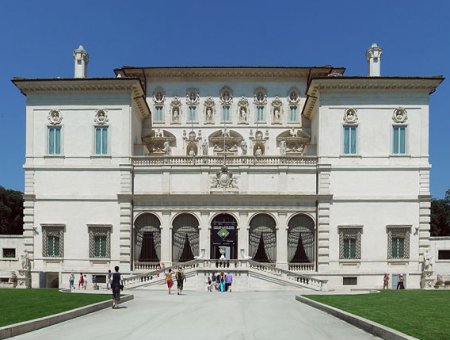
Borghese Gallery
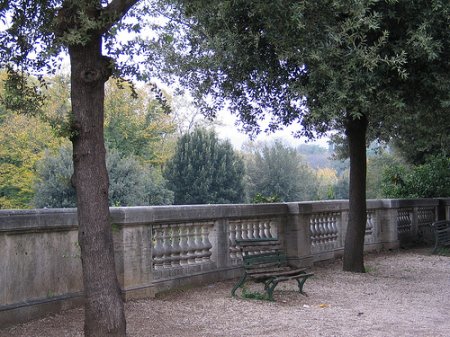
Villa
Borghese Grounds
|
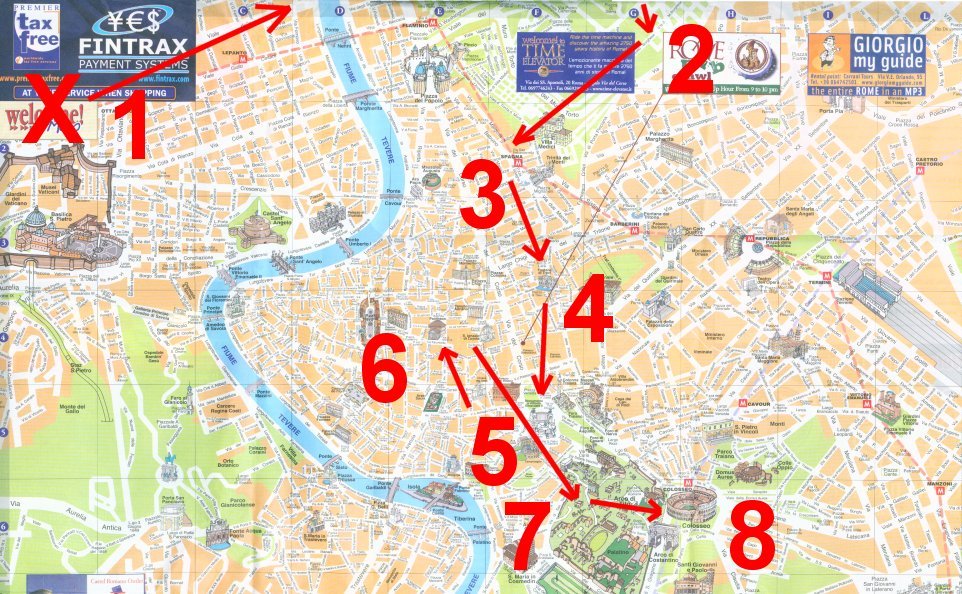 |
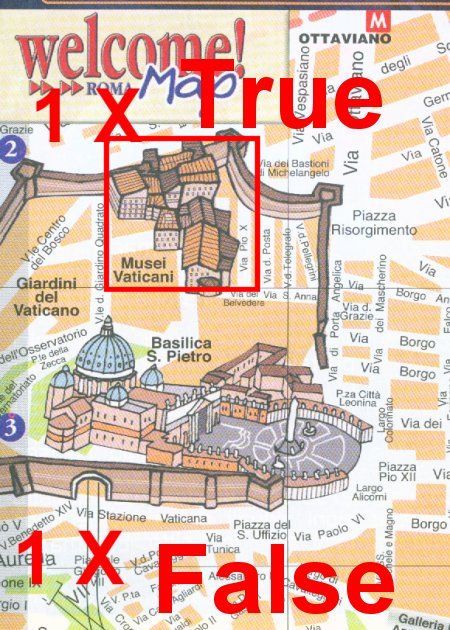 |
My
confusion was directly related to my
lousy map. As I mentioned earlier, I was convinced the
Wall in front of my hotel window was North.
What I did not realize was the true location of our hotel was
hidden. When I first saw this
map, I assumed the Hotel Alimandi was in the False location.
It was an easy mistake to make because as you can see the True location
of the Hotel was obliterated from sight by the "Welcome
to Roma"
caption. My reality of Rome was upside down!
We were running out of time. Should we take the bus
going to my left or to my right? I decided the sun was
my best friend. I would follow the sun and hope for the best.
So we caught the first bus going to the
left even though my brain was very unhappy about the confusion.
Not surprisingly, my confusion caused me to
make a mistake.
It didn't dawn on me at
the time, but just because the bus was heading to the east
didn't mean it was heading to the east.
Let me explain. Shortly after we got on the bus,
it turned left. The bus was now headed north. Although
I didn't know it at the time, we had indeed
gotten on the wrong bus.
Now that we were not headed towards the sun, I immediately worried
that something was wrong. I was still
using this limited map of Rome given to us
by the hotel. The street where we had
caught the bus was definitely on my map, but after the bus turned
left, not
one of the new streets appeared on my map!
This bus had literally gone off the map!
Where we were we going?!?
I started to panic. I knew I had made a guess to begin with.
My biggest concern was that we were heading west in the opposite
direction. That made sense because 'west' was off the map.
I was deeply confused.
|
As the
bus wandered into areas not on my map, I studied my map furiously.
That's when I made a discovery. I noticed
the Vatican Museum we had visited yesterday was at the top of the
Vatican City (see the red square
in the picture above). That is when it dawned on me -
my Hotel must be above of the Vatican City,
not below it (see
True location).
In other words, when I faced the Wall in front of
my hotel room I was actually looking South,
not North!
In one sudden Galilean inspiration, my world had just flipped 180
degrees. This was going to take a while to get used to… but I didn't
have 'a while' to spare!
Marla had no idea the extent of the panic I was in, but she could
tell I was worried about something. She sensed we were in trouble.
Just how lost were we?
Marla just kept staring at me with a very dark look.
You see, there was only one stop on this entire trip
Marla deeply
cared about - the impressive Borghese Art Gallery.
This is such a popular location that you actually have to reserve a
two-hour visiting block ahead of time. You cannot drop in
unannounced. My mind wandered back to the
day Marla had spent an hour on the Internet trying to figure out how
to make our reservation to visit. This visit was practically
all she could talk about.
|
 |
Now we had
only 20 minutes left to make our
appointment. Not only that, we had pre-paid
our visit. If we didn't show up, that money was down the
drain. The pressure was really getting to me.
This would be our one and only chance to
see this place! I
was poor, I was lost, I didn’t speak the language, and I had 20
minutes left to get there or my wife would blame this fiasco on me.
It had been MY DECISION to get on this bus and I
was convinced something was wrong. I
was deeply worried, but I did not know what to do. Where was
this bus going?
 |
It was about this point
that the comedy began.
As we sat on the bus wondering where we were, the three of us
tried different strategies. My strategy was to continue to stare
helplessly at the street signs and hope a street would appear that
was on my map. Marla's strategy was to talk to the three people
closest to her on the bus. Meanwhile Sam interviewed a fourth person. Not
one person spoke English. Well, change that, they all seemed to
understand a little English. This is another way of saying that
Marla and Sam spoke English while the Italians nodded their heads a
lot and waved their hands.
I have to give the Italians credit - all four of them tried very
hard to help. All four people were trying to
explain things to us using sign
language and broken English. But I paled even further when I saw
that none of them could agree on where we were headed! They started
arguing among themselves pointing in opposite directions and
gesturing wildly. What did I get us into?
Watching this charade, Marla, Sam, and I didn't know what to do. As
I stared at the map, I could see there were two bus stops next to
the Borghese that had been circled by the woman at the hotel -
Flaminio and Spagna.
So I said, "Bus go to Flaminio?" and pointed down the street
hopefully.
"No Flaminio! Bus no go Flaminio!" They all agreed on this account!
My heart sank.
|
Then I tried my next option. "Spagna? Bus go to Spagna?"
Same thing. "No Spagna! No Spagna!
Bus no go to Spagna!"
I
understood them very clearly. Their English was improving as my
prospects were diminishing. This was looking hopeless. I could feel
our chances of getting to the Borghese in time
were slipping away by the
moment.
But one very polite man with spectacles spoke up
and said, "Bus go to
Borghese. I show you."
That was our only ray of hope. But it was no sure thing.
The other
three kept shaking their heads in disagreement. It was three against
one. Our hero was outnumbered.
Confronted by the contradictions, Marla didn't know whom to believe.
She kept interviewing all four people without any real success.
However, unbeknownst to Marla, I was
starting to cheer up a little. Two very good things had happened.
First, the bus must have turned a second time because I noticed we were
headed towards the sun again. Second, we
had crossed a very large river.
That had to be the famous Tiber River
which ran through the center of Rome. Not
only was the Tiber River east of our hotel, part of it ran very
close the Borghese Gallery. I still didn't
know where we were, but I was encouraged nonetheless.
Shortly after we crossed the Tiber, the man who had promised the bus
was going to Borghese spoke up with conviction, "Trust me! Trust
me!"
Marla looked at me and I nodded. We
decided this guy was our man.
Why not? What
were our other choices?
|
|
 |
At the Italian man's bidding, very soon we all got off the bus. To
our surprise, the man got off too. I remember thinking it was kind
of odd that he got off with us. I also noticed Marla had a big frown
on her face, but I didn't have time to figure it out. Instead I
looked around for street names. Not one street sign was on
my map. Pardon my Italian, but this sucks!
|
The Italian guy pointed down the street. He seemed to indicate he
was going to lead us there. So the three of us followed our Italian
amico in silent prayer for four blocks. My gut
was knotted with anxiety the entire time.
The
Gallery was still nowhere in sight, we had eight minutes left, this
guy didn't speak a word of English and we still had no clue where we
were. Where we were going? Marla looked very unhappy. I
didn't blame her a bit. So was I.
Just about the time I wondered for the twentieth time if this
guy knew what he was doing, Marla entered the Twilight Zone, her
favorite TV show.
Marla suddenly got a very worried look on her face. She
pulled me over and whispered, "Rick, I saw that man put his hand in
his pocket. I saw a gun in there! He has a small gun!
And we have no idea where he is leading us!"
Now I entered the Twilight Zone as well. The theme to the
Twilight Zone started to play in my brain like a broken record.
A gun? Were we in danger? Was he setting us up?
|
 |
|
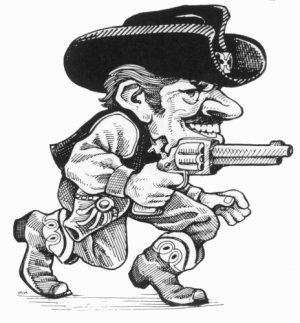 |
For the record, I was skeptical.
I seriously doubted the man had a gun in his pocket. I
wasn't sure if this man knew where he was
going, but I had not gotten even the slightest bad vibe from
him. His appearance was not exactly the
Desperado type.
He was a skinny guy, clean cut, maybe 5' 10"
and 150 pounds. He wore office clothing
and looked like a
bookkeeper. He didn't
have a muscle on his body and he wasn't tough
looking at all. In fact, he was much closer
in appearance to Mr. Rogers than the
Godfather.
But I also saw no reason to override Marla's fears.
I could see she
was serious. If
Marla was right, we
could be in a lot of trouble.
Better safe than sorry.
Fortunately at that exact moment Marla and I noticed a very
expensive hotel just around the corner. So I told the perplexed man
grazie, then suddenly changed directions and hustled my family
over to the safety of the hotel. Our companion had a very confused look on his face,
but he made no attempt to follow us.
|
Miraculously, our decision
to part ways had a silver lining. There were taxis!
Yes! We were about to get a taxi when a man walking
his dog heard us speak the word 'Borghese'.
In perfect English he
said we didn't need a taxi. The entrance to the Borghese Gallery was
only one block away! He pointed in the same direction the man had
been taking us. All three of us stared at the man with incredulity.
You have got to be kidding!
In a flash we had just gone from 'off the map lost in
the middle of nowhere' to 'robbed and murdered'
to 'here we are'. How weird is that?
As relief came flooding in, I could still hear the Twilight Zone music playing in the
background, theme song for the Adventures of Rick and Marla and Sam.
Following the dog walker's suggestion, we soon found
the entrance to a huge tree-filled park.
As we took a leisurely stroll through the grounds, two policemen on
horseback came by. I said 'Borghese Gallery?'
They smiled and pointed me in the right direction. Finally!
We now had five minutes to enjoy our triumphant stroll through the
gardens before our
visit to the magnificent Borghese Gallery.
In
retrospect, I believe our mystery man was leading us straight to one
of the entrances. After all, the hotel we found was
right across the street from the grounds. We owe him a favor for getting us there.
But
in Marla's defense, he may have indeed had a gun, perhaps for his
own protection. Who knows?
All I know
for sure is that we got very lucky.
|
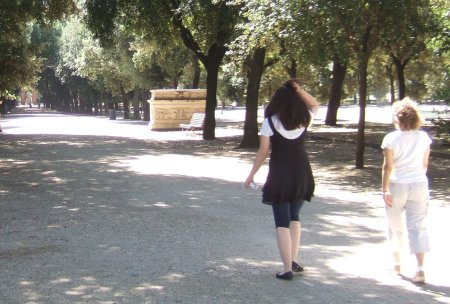
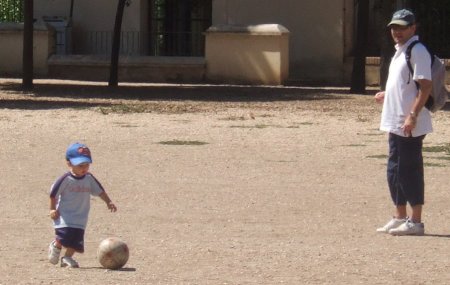
Italy won the 2006 World Cup in soccer.
As you can see, they start 'em young. |
Just to put some closure on
this 'Lost in Rome' story, while I was at the museum I
studied the map on the right. The map of the Borghese grounds
helped me understand what had gone wrong with the bus trip.
As you can see from the picture below, our bus did not take a
direct route to the Borghese Gallery. When the bus made its
left turn, it took us off the hotel map to the north. This
explains why the hotel map did not show the streets of our bus
route.
Flaminio was at the western entrance. Spagna
was at the southern entrance. The Gallery itself was
at the eastern entrance. The northerly route of the bus
explained why everyone said no Flaminio and no
Spagna.
They were right. Our bus route went nowhere near
those spots (I think we were about a mile north of
Flaminio).
Looking
at the Borghese map, I could see we had entered the grounds from the
northern side. The bus had indeed passed within several blocks of
the Borghese Gallery, but from the northern side that was not
included in my limited hotel map. So our man with the gun was
right too.
It may have been
the wrong bus, but fortunately the bus at least passed within
walking distance of the Borghese Gallery .
What a crazy morning! But, as Shakespeare would say,
'All's well that ends well.'
|
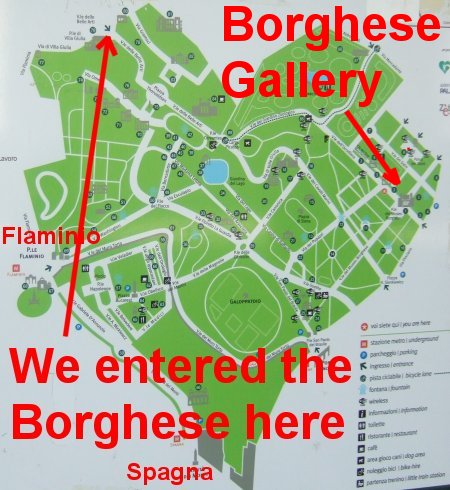 |
|
 |
|
|
|
|
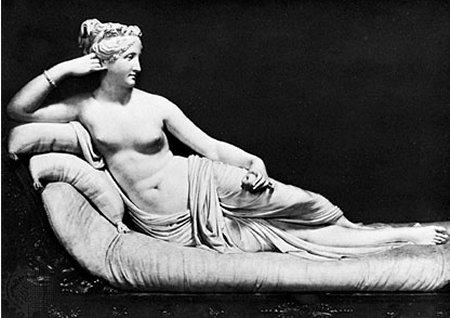 |
Our Visit to
the Borghese Gallery
The Borghese Gallery turned out to be even better than
advertised. Such beauty. Plus they had air-conditioning and took
credit cards! My kind of place.
We were about to get an audio guide when the lady suggested
that using a human guide was far superior. So
we took her advice. Good move.
Our guide was a tiny Italian lady,
28, who was obviously an art major and VERY PASSIONATE about her
love of this Gallery. She made all the magnificent sculptures and
artwork come alive for us.
Impressive were the sculpture of Napoleon's sister
Paulina by Canova (pictured at left),
as well as Renaissance paintings by Raphael, Titian, Van Dyck,
Carravaggio and Corregio.
|
Although I am hardly an art expert, in
my opinion, the star of the gallery was Gian Lorenzo Bernini.
Our
friendly guide showed us several different sculptures done by
Bernini that were unbelievably lifelike. The most famous was
Apollo and Daphne. Another one was David right
before he throws the stone at Goliath. The third was Pluto and
Persephone. These
three were pretty amazing sculptures.
As I study the pictures below, I can
promise you they don't do justice to the incredible detail involved
in these larger-than-life projects. It was
very obvious we were in the presence of
genius.
Of course I felt very overwhelmed as we toured the museum.
Bernini
was the star, but there were so many other
works of art throughout the gallery that were
famous in their own right. My head was
spinning at all the deeper symbolism our guide explained to us in
marvelous detail. I quite honestly had no idea there was so
much secret code and hidden meaning in art!
It was probably the most culture I have ever been exposed to in my
life other than my recent case of athlete's foot (support
bacteria; they're the only culture some people have).
All kidding aside, this was my favorite visit of the trip. I
am grateful to Marla for scheduling our time here.
|
|
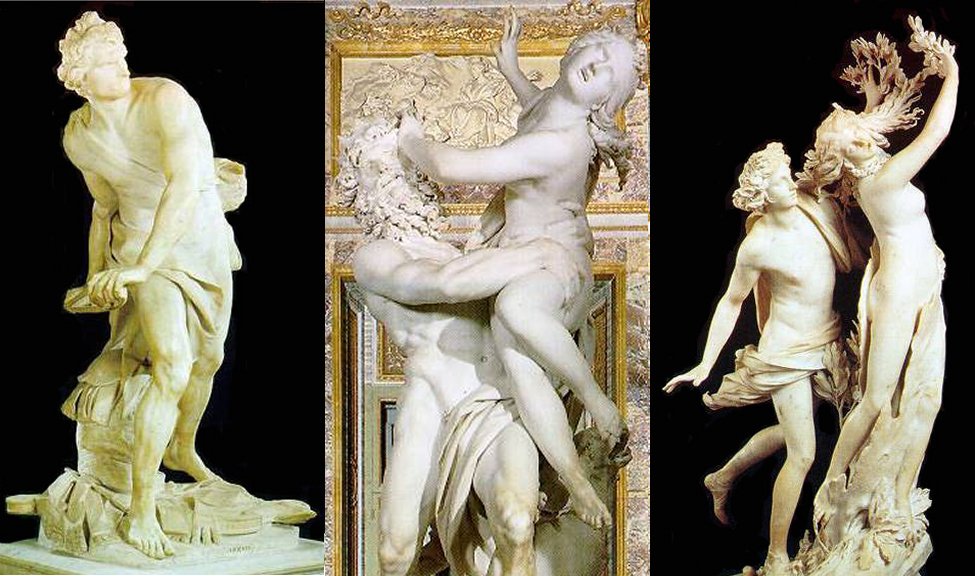 |
|
|
The
Spanish Steps
The remainder of the day was pure joy as we
followed the map and wandered through the streets of Rome on foot. As
we were leaving the Borghese Gallery
at 1 pm, Marla said she was happy now. As far as she was
concerned we could do whatever we wanted for the rest of the day.
Now that I had successfully become
oriented with layout of Rome, the hotel map and
I were no longer enemies. Looking at the map,
I could see the famous Spanish Steps
were just beyond the southern
border of the Borghese estate. We also noticed the
Colosseum was at the bottom of our map.
We had been told you could get practically anywhere in Rome by
walking, so we decided to see if this was true. Using the trek
to the Spanish Steps as an experiment, we made walking
the entire city our goal for the day.
Since we were
poor, walking made a lot of sense. It didn't hurt that the
first part of our journey took us through the beautiful gardens of
the Borghese estate!
It turned out this advice about walking was correct.
As the day unfolded, we were definitely able to confirm that
most of the famous locations were within walking distance of each
other (assuming you have all day to walk,
that is).
Although I am getting a bit ahead my story, later that day at the
Colosseum we had a guide who pointed out that
Michelangelo had stolen many rocks from the Colosseum to help build
the Sistine Chapel in the Vatican City
just two miles away. I
was a little skeptical at his 'two miles
away'
part of the statement, but his point reinforced my notion that
the most important parts of the ancient
city were definitely within walking distance.
I also smiled when the Colosseum guide
referred to the Borghese Gallery as a
remote country villa
located 'far away in the distant regions of Rome'.
Out in the country? We had
been able to walk from the Borghese 'country estate' over here to
the Colosseum in less than five hours! The
thought of the remote Roman 'countryside' being all of
two miles away was amusing for a boy raised in the vast State of
Texas. If you want a better definition for
the word 'remote', try walking from Katy to
Downtown Houston in five hours.
Good luck.
After a brisk 20-minute walk southward
through the lovely Borghese gardens, ta da,
we were suddenly treated to the beautiful view of the famous
Spanish Steps, a favorite tourist stop here in Rome.
The 138
Spanish Steps are indeed
wide and very steep. They are so beautiful
that they have served as a backdrop for many movies
shot in Rome.
Up at the top of the stairs stood a beautiful
church known as the Trinità dei Monti (in
English it is the Church of the Holy
Trinity atop Pincio Hill). This
famous church is well known for its scenic dominance above the
Spanish Steps that descend into the
Piazza di
Spagna.
The Church of the Holy Trinity was important
to my daughter. Sam attends Duchesne Academy of the Sacred Heart
here in Houston, a Catholic girl's school. Although we are not
Catholic, I have to admit that 13 years of this marvelous Catholic
education has definitely had its impact on her. Sam
definitely wanted to go have a look due to
a special link between this church and Sam's school.
As Sam explained it to me,
this church is run by the Religious of the Sacred Heart,
which is same society of nuns that run
Duchesne Academy. These nuns are affiliated with Society of the
Sacred Heart, which was founded in France by Madeline Sofie Barat.
The Religious of the Sacred Heart run schools all over the world. Besides the dozens of schools all over the US, there are
Sacred Heart schools on
every continent.
In 1844, a young girl studying at the convent in Rome painted a fresco of
the Virgin Mary. When the painting was completed, the Mother
Superior of the convent threw a curtain over it. She was
convinced it was too ugly to be on display constantly.
However, two years later, Pope Pius IX took a trip to the
Trinita dei Monti and asked to see the painting behind the
curtain. Begrudgingly, the Mother Superior uncovered the painting to
discover that it had become a beautiful painting of the Mother of
Jesus. The paint had faded over time to depict Mary perfectly.
That day, the Pope named the painting Mater Admirabilis
- Mother most admirable. The painting is extremely
special to Sacred Heart Schools, and to this day a recreation of it
sits in the foyer at Duchesne as well as other Sacred Heart schools.
|

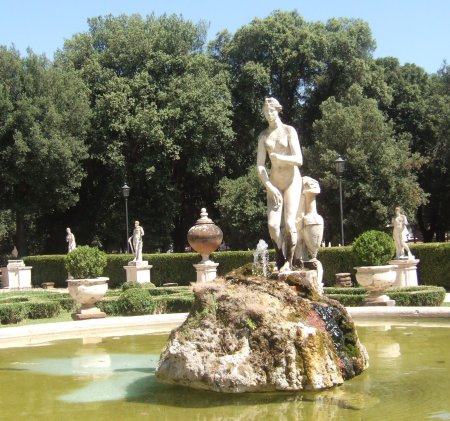
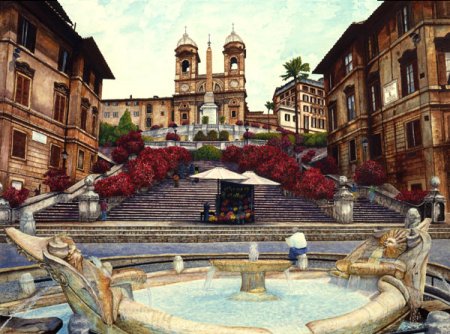
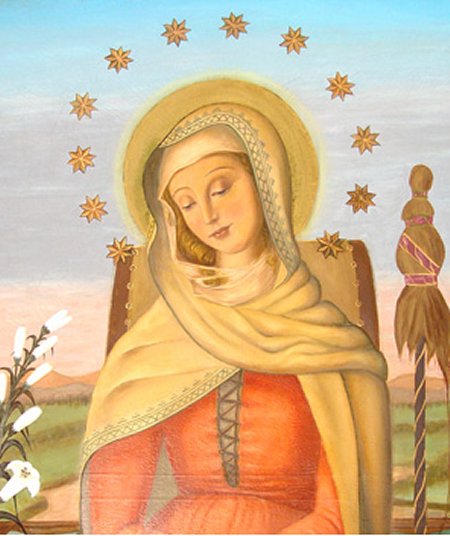 |
Caveat Emptor: The Great Gelato
Shakedown!
|
After the Spanish
Steps, it was time for some ice cream. We were about
to encounter the single defining moment of the trip.
Let me paint the picture. It was hot. It
was crowded (hundreds of people were
milling about in the general area of the Spanish Steps).
It was afternoon. It was time for food. I suggested pizza or gelato.
Marla said whichever we found first worked for her.
We soon came across a small sidewalk shop that sold soft
drinks, water, and gelato. The name was
Caffetteria Antica Roma. Thinking back to how fast our gelato (Italian ice cream) had disappeared the day before,
I decided to move up to an ice cream cone a
little bit larger.
Yesterday's scoops had cost 6 Euros. I picked the cone
in the red rectangle
(see picture). I figured I could afford
a little more, but I didn't go overboard. As you can see
in the picture, there were only two smaller sizes.
The young man not only gave us each three scoops of ice
cream, he put some colored decorations and little
Italian flags on top for
good measure. How pretty! That was definitely the fanciest ice cream
cone I had ever seen.
As Marla and Sam hungrily devoured their gelatos, I walked
over to another part of the store to pay. I stood
in line behind four
customers. Some old guy was slowly but surely
collecting the money. I had not been given a bill or a price.
I had
no idea what the cones cost, but since this cone
wasn't much bigger than the one from the previous day, I wasn't
worried.
This was a pretty loose operation. There were no doors and it
was very crowded. The three of us could have walked away and no one
would have known a thing.
It occurred to me that if I wanted to
pay for one cone instead of three no one would have ever known the
difference. After all, I didn't have a
receipt. I experienced a moment of
weakness. Considering how poor I was feeling,
maybe I could fool him. But after a brief contest between good and evil,
my conscience won. I
thought how Kahlil Gibran had once said
it is much easier to be a moral person when you have money in your
pocket. Hmm.
Now it's my turn. The old guy looks at me and asks how many.
Three. Without even looking up he says "36 Euros".
What!!! I
practically died from shock!
36 Euros!!! Are you out of you mind! Suddenly
the Twilight Zone music started playing in my brain again. I was in
shock.
As I clung to my money, I did some rapid calculations. How
could 6 Euros of Gelato yesterday suddenly multiply to 36 Euros
today? I had surely not increased the size of my ice cream by a
factor of 6. There must be a mistake.
36 Euros = $72. Who on earth charges $72 for
3 ice cream
cones!?! My entire dinner last night for
3 people complete with wine had come to 42
Euros. Why does this guy charge
so much for ice cream?
He stared at me and I stared back
at him in silence. It was so quiet he might have been able to hear
the Twilight Zone music playing in my brain. Did I remember to set
my ears on mute?
I tried to protest only to realize he didn't speak English!
He only could speak in Euros. How do you argue with someone in
another language? Just then two cops walked by outside. One word
from this guy and I am sure the polizia strolling down the piazza
would have flattened me like a pizza. So I begrudgingly handed over
my precious Euros and shed huge secret crocodile tears inside. How
would I ever be able to enjoy my ice cream cone knowing my
deep-seated Puritan sense of thrift had just been ripped into ugly
bloody shreds?
Marla wasn't very sympathetic which didn't help much. First
she insinuated how stupid I was for not asking the price ahead of
time. Then she pointed out the cost was listed. As the
new clouds of
depression set in, I dully scanned the price list. There were
prices for over a dozen different sizes of
cones. And yes, one of them said 12 Euros.
But as I stared at the
different sizes of cones on the shelf above, how was I supposed to
know which cone size correlated with which price?
I thought that was
a pretty good argument on my part. Why hadn't they put a picture
next to the price?
Marla pointed out I had selected the largest cone
size in the display. But her argument
didn't make any sense. There were several sizes larger on the
menu as well as smaller sizes. I
even saw cones listed that cost 25 Euros! Then it dawned on me
that maybe the confusion was deliberate. Hmm. It worked.
As the Twilight Zone music kept playing
over and over in my head,
I was reminded of a very old saying in Latin
- Caveat Emptor…
beware the buyer. I had just fallen into la crème de la
crème of Roman tourist traps, the great Gelato shakedown!
As I realized what a fool I had been, what should have been a
happy moment instead turned to Dark Depression.
It takes a complete and total moron to spend
25% of his last remaining cash on 3 ice cream cones.
I had honestly not felt
this poor since I was a struggling grad student waiting in the food
stamp line forty years ago. In an idle moment I wondered how the
Monster Mash would be received on the
streets of Rome.
Should I dance
and entertain in a
desperate attempt to raise cash?
|
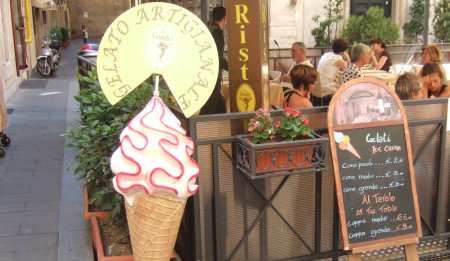
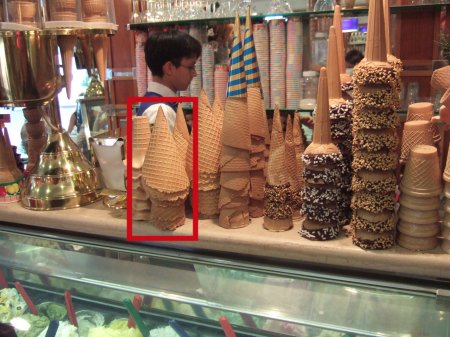
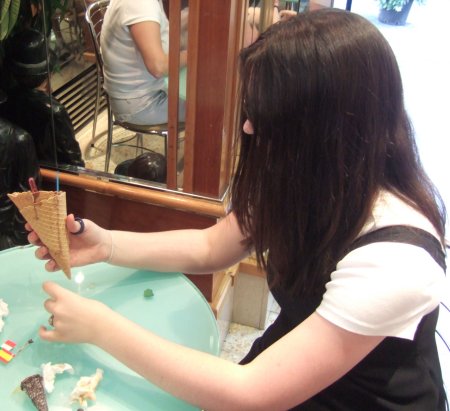
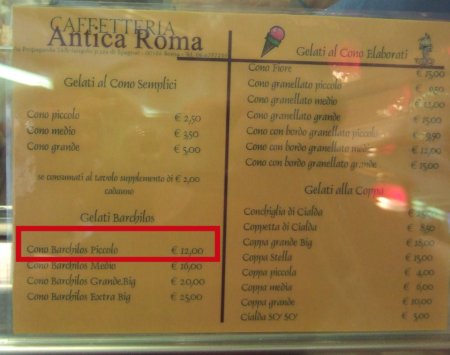
|
Marla visits
Caffetteria Antica Roma
on the Internet
Note: After Marla read my story, out of
curiosity, she googled Caffetteria Antica Roma.
Apparently my experience was not a random one. We had stumbled
into a well-known tourist trap!
As you will see, this little sidewalk cafe has a very bad
reputation.
Mara's discovery brings up an interesting thought.
I wonder if tourists of the future will carry portable devices to
check the Internet reputation of every location before entering. RA
|
 |
4 Apr 2008
I know my story is nothing new among seasoned travelers,
but I could still be a refresh warning for
the more "rookies" of us all...
So, there we were, in Rome for the first time, me, wife, and 4 kids,
just a few hundred meters from Piazza di Spagna, and the kids
see this Gelateria (ice cream shop),
Caffetteria gelateria Antica Roma, located
in Via di Propaganda 26, just seconds from Piazza di Spagna
and the famous "Trinità dei Monti".. My wife enters the
Gelateria with the kids, and i chose to
stay outside to take pictures and keep watch
on our youngest one, still in the stroller.
Now, being an Italian myself, I should have seen it coming, but not
at this level. My wife came out of the
Gelateria with the kids, iced cream cones,
and a *very* strange expression of guilt on her face. She
told me that she was charged and in a moment of brain stress
induced brain blackout, she paid 90 euros
for the ice creams. That IS correct, 90
EUROS = 135 US Dollars, for: 4 ice cream
cones with 2 scoops each, plus a small cup
with one scoop, plus a small slice of tiramisu. 9
Scoops of ice cream and a slice of cake, 135 dollars... And
yes, I still have the receipt and a
picture of the ice creams...
Guys, when in Rome, FIRST, ASK FOR THE PRICE !!! if it seems too
much, turn around and *leave*.
(Rick's Note:
I wish I had done this myself!)
There are no words to describe how stupid and cheated I felt.
I should have gone back in, called the police, and created a
huge fuss, but I did not, my bad, my loss.
Truth to be told, Rome is gorgeous. Just treat the downtown area
like "enemy territory" when it comes to
eating and drinking. If budget is an
issue at all, stay in the outskirts, like we did, and use the metro
to go downtown.
(See
original Writeup)
RICK
ARCHER'S NOTE: The next four reviews were found by Marla on
Travel Buddy. I was so amused, I took the time to my add my
own story as well.
Sep 05, 2007
If you are at the Spanish Steps, and feel like an ice
cream. Under NO circumstances should you go to this place. We paid
9.80Euro for EACH gelati we had. That is, we paid 30E for 3 small
gelatis.
It's the most expensive ice cream i've ever had.
9Euro of that was just for the shit seats we had. My mum stood there
arguing with them for 10 minutes but no one in the shop would even
talk to us and all pretended to not know what they should actually
cost. Meanwhile the gelati was melting and wasnt even that good. We
had much better elsewhere in Rome and much much cheaper too....
(See
original Writeup)
Mar 21, 2008
You are totally right, we paid 7.50 for each cone. The
cashier (tall woman with dark brown hair) said we had eaten 7.50
worth and had to pay that amount. We argued with her, because there
was a sign "2.50 each per cone", but she said our cones were bigger
than this size. I think she has different measurements for tourists
and romans. We had similar experiences with other places in Rome and
we will never go back to this country. After that we were in
Barcelona. This town was cleaner and the people were nicer and were
correct in money matters etc. We were in Italy in 1984 and they
cheated us back then also.
Don't go under no circumstances to this place. Sorry, but
historic places AND people count! Try to find a Asteria to eat they
usually are family owned and may not cheat you as easy.
(See
original Writeup)
Mar
31, 2008
This place is evil. My boyfriend ordered a gelato in the
smallest, plainest looking cone and when he went to pay they charged
him 7.50 euros. I was sure there was a mistake because I had just
been to the place about 3 weeks before with a friend and I am sure
we did not pay over 3.50 euros for our gelato.
There were also people with giant cones, elaborately decorated with
wafers and stacked with scoops...now I cant imagine those people
paying 30 euros for their ice cream.
After he paid, I asked the lady at the cash register if it was 7.50
euros for just ONE small cone of gelato and she rudely said she
didn't know and the man serving the gelato tells her the price.
I went back to the man who served us the gelato and asked him the
same question and he pretended he did not speak English even though
he did less than a minute ago when he served us. At first I was
confused so I repeated myself and asked him again and he started
speaking Italian really fast (which my friend and I could
understand) and he said arrogantly "Speak Italian, I don't know
English, speak Italian!!! Italian only!" So my friend asked in
Italian if the cone my boyfriend had was 7.50 and she pointed at the
sign that clearly said 2.50 euros for a small cone of gelato. The
man pretended to not understand her Italian and started yelling at
her in Italian and then he waved his hands at us in a shooing and
degrading motion telling us to leave. This whole time we were being
polite, but I got upset at this and told him I had been here before
and I didnt pay 7.50, and I said the sign says 2.50. He started to
mimic me mockingly, making faces and continued waving us away.
I don't think it would be so bad paying 7.50 euros for a tiny ice
cream if they had not been so rude and avoided my questions.
(See
original Writeup)
Posted on: Apr 02, 2008
haha! we had the exact same scam! the lady at the till
pretends to not be responsible for the cost. and the guy making them
pretends not to understand. so they just make the most expensive
thing there is whether you want it or not. my mum is actually
Italian and spoke perfect Italian and they were still rude and
pretended not to understand. It's a total scam. They also charged
3Euro for EACH of us to sit down....
(See
original Writeup)
Rick Archer's Note:
So there you have it.
I had the distinction of being ripped off by one of Rome's most
famous tourists traps. Lucky me.
|
Trevi Fountain
It took a while, but
eventually I was able to carry on with my life. I ambled listlessly
southward along the Via del Propaganda. I wondered
what ‘propaganda’ meant in Italian. Probably something like ‘Street
for American suckers’ or some phrase as equally
cheerful as that.
Eventually my spirits returned. I noticed we were just a few blocks
from the Trevi Fountain. A couple minutes later,
there it was in its entire splendor. The Trevi was the biggest
fountain I had ever seen in my life. The size wasn’t the only
impressive part of the fountain; the sculptures of the various Gods
and Goddesses were just incredible.
I could not imagine the skill and the work that when into creating
something this beautiful. Overcome by the splendor, I was so happy
I started to sing ‘Three Coins in a Fountain’.
People will tell you I don’t sing well. I received further proof
when suddenly I was hit by a hail of coins from people trying to
shut me up. You would think my feeling would be hurt, but it
wasn’t. Instead, like a thirsty man hungry for water, I fell to the
ground and groveled for the coins.
Maybe one of them would be a Euro, a coin infinitely more valuable
than gold itself! No such luck. Just a bunch of worthless pennies.
Darn. Still broke. Obviously its tough to sing for money
when you have no talent. I chucked
the whole lot of them in the fountain. Maybe my luck would change.
As a side note, I later discovered my new best friend Bernini had
first designed the magnificent sculptures at the Trevi Fountain.
Although he didn’t carve them himself, later artists faithfully
reproduced his models. Wonderful place.
|
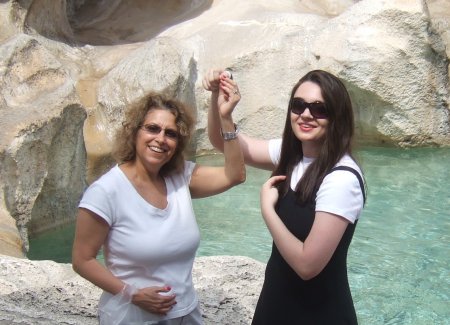
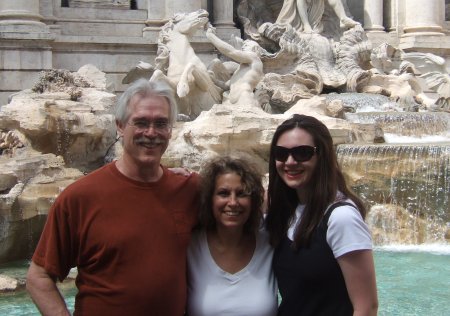 |
|
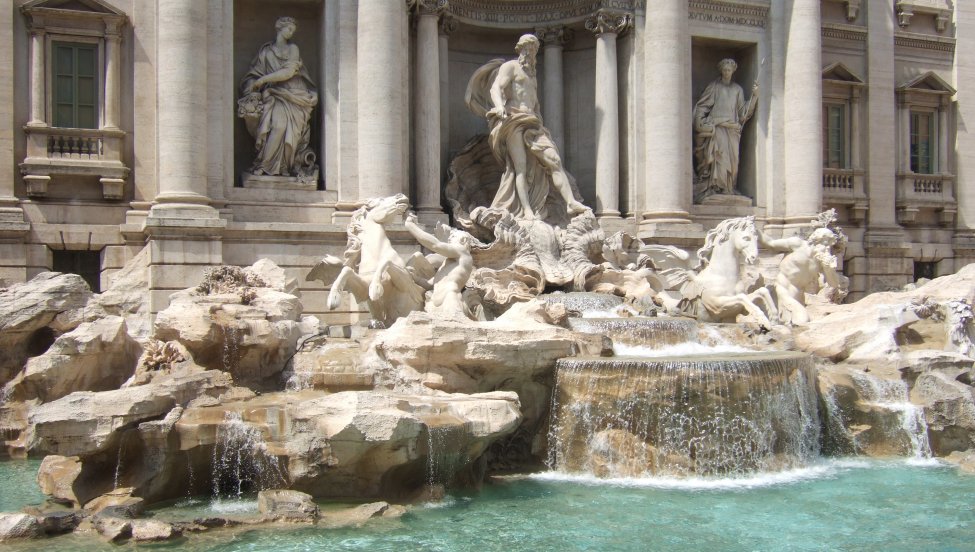 |
Victor Emmanuel and
Pantheon
As we continued to stroll southward towards
the Colosseum, out of nowhere appeared the marvelous Victor
Emmanuel Monument
(see picture on the right).
This was quite an impressive structure. However, I had no idea
who this man was. I was immediately
curious to find out what
Victor Emmanuel was famous for, so I read up on him as
Sam, Marla and I strolled
over to the nearby Pantheon.
It seems that after the Goths got through finishing off the Roman Empire
around 476 AD,
during the Middle Ages the Italian Peninsula had divided into
several merchant states. As you can see from the
picture, there was the Republic of Venice, the Republic of
Florence, the Kingdom of Naples, the Papal States, the Republic of
Genoa, the Republic of Siena, the Duchy of Milan, and
6 other
smaller territories as well.
Apparently back in the 1800s, a century
when all the European powers were constantly at war with one
another, these various individual states were under the control of
different foreign powers.
In other words, Italy as we know it today did not even remotely
exist. These various states were too small to wield any real power
on their own,
so they existed under the control of their two
powerful
neighbors Austria and France and to some extent
Spain. Furthermore these various states had
no interest in merging with one another. In fact, they were usually
fighting each other during this era. Things stayed this way for hundreds of years.
United we stand, divided we fall.
Two men changed all
that. Victor Emmanuel with plenty of help from a brilliant general
named Giuseppe Garibaldi began to reunify Italy
by merging one piece of the
puzzle at a time.
Garibaldi started things off around 1848 by uniting the southern
part of Italy. This area was much too remote for the European powers
to show much interest. Their claims were in the central and northern
parts of the Italian peninsula. France and Austria were determined to keep
these territories in their place, but Southern Italy was just barely
beyond their reach. So Garibaldi was able to gain at least a measure
of strength without being squashed by France or Austria.
Garibaldi and Emmanuelle joined forces in the 1860s
(the same time as the American Civil War).
Using
Southern
Italy as their initial base of operations, these two men began the
reunification process. Emmanuelle
was very clever in his method.
Normally you think a revolution is the way to gain independence. Not
Italy. The city-states had no desire to be united and
Emmanuel/Garibaldi had nowhere near enough strength to force these
states to do it anyway. What Emmanuel did was offer to fight
alongside one superpower against another superpower in the
wars that plagued Europe in the 1800s.
Emmanuel was the politician
who was always busy making treaties with the major powers. Garibaldi
would then fight whatever messy battle Emmanuelle had gotten him
into.
Emmanuel played one major power against another. He was
constantly changing sides. By periodically aligning with the
major players, Emmanuel positioned his small kingdom to pick up
little pieces of territory here and there.
For example, France and
Austria would fight a war with Southern Italy playing a small role.
It didn't matter who won or lost. Even if it was their ally who
lost, after the war Emmanuel and Garibaldi would pick off one of the
loser's Italian territories and add it to their collection. They
gambled the bigger nation was too preoccupied with post-war
headaches to come down and reclaim their prize.
Pretty soon there would be another war, maybe this time France and
Germany or Austria and Russia or Prussia and Hungary. Again when the
bigger nation was preoccupied, Emmanuel and Garibaldi would pick off
another territory. One by one, the merging territories
were growing bigger.
Soon they had an army sizable enough to play with the big boys.
At this point, they began to acquire their new territory directly.
They would pick a fight with France or Austria over the Republic of
Siena. Austria would send down some troops. Using his home field
advantage, Garibaldi would win the battle. Now Siena belonged to
them. Emmanuel and Garibaldi had picked up another piece of the
puzzle and grown stronger in the process. Italy
was becoming as powerful as its neighbors.
In all it took about 20 years, but eventually a new nation was
formed out of all the original dozen city-states.
By coincidence, as Marla, Sam and I arrived at the enormous
Pantheon (see
picture on the right), I discovered that Victor Emanuel was buried there.
Quite an honor and richly deserved!
The Pantheon has always been known as the Resting
Place of Heroes.
As you can see, Victor Emmanuelle
has been properly immortalized as the Father of this new country
named Italy. He is the "George
Washington" of Italy.
|
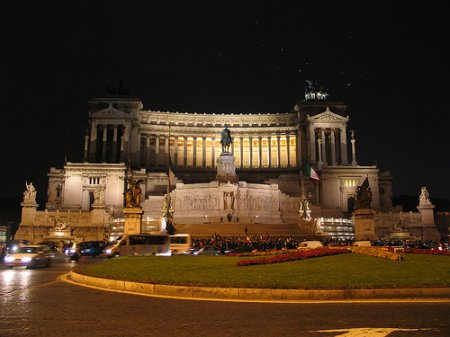
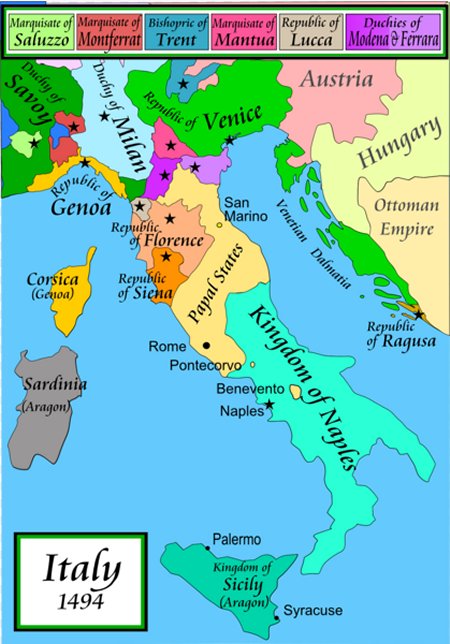
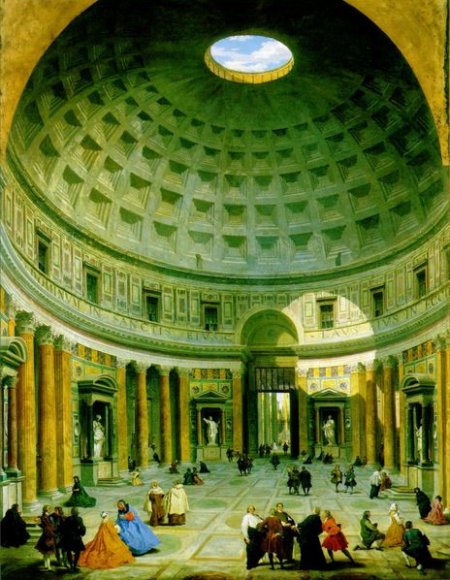 |
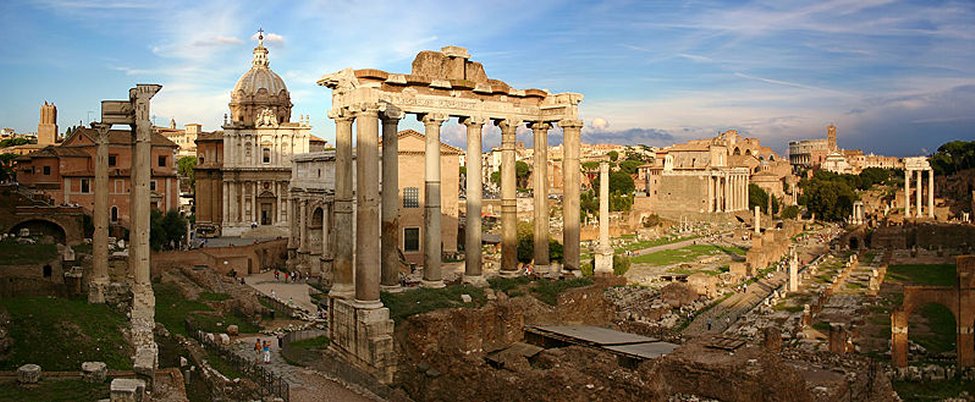 |
The Roman Forum, Julius Caesar, Augustus Caesar and
Birth of the Roman Empire
|
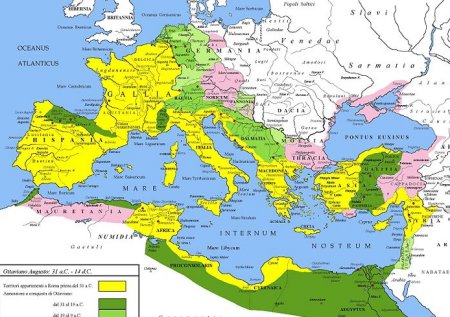 |
After the Pantheon, it was time for the final push to the Colosseum. But
first we had to stop and take a look at the Roman Forum.
The Forum was located about halfway between the Victor Emmanuel
monument and the Colosseum. It was about 5 pm. We had neither the
strength nor time to actually walk down into the Forum area. So we
contented ourselves with sitting on a sidewalk high above and
looking at it from 200 yards away.
Marla got out her tourist book and started
identifying the different structures. I could see it broke her heart
not to go down there and touch every marble column and historical
broken rock with her bare hands. I have no doubt that Marla was
a Roman dictator in a previous lifetime.
The ancient
memories were undoubtedly calling to her subconscious.
As Marla stared at the Forum and reveled in her
glory days of yesteryear's Imperial Rome, she let me look at the
book. While reading the tourist guide I
ran across Caesar's famous
quote Veni Vidi Vici - I came, I saw, I conquered.
That
brought back memories of my own. How can I forget those words?
You see, I took two years of Latin in the 8th and 9th grade.
In my classroom, a banner of Caesar hung with those immortal three
words. I stared at that banner on many an occasion.
I consider my two years of Latin to be the single greatest waste of time in my entire
childhood. I had no choice - Latin was part of the classical training to be endured at my
college prep school. Humph. In my opinion,
my time would have been better spent in
auto mechanics or a typing class. At least then I might
acquire a skill that could actually prove useful later in life.
But no, Latin was mandatory at my school. I have always chalked up my Latin class experience as my Peggy Sue
Got Married moment. To refresh your memory, Peggy Sue got a bump on
her head and woke up back in her teen years. Although she
was
confused by this new/old world, she was
fascinated at her unexpected chance to
relive high
school all over again. Peggy Sue thoroughly enjoyed saying
the things she always wanted to say back
then (don't we all!)
My favorite moment came when she
handed in a blank math test. Peggy Sue then informed
her math teacher she knew for an
absolute fact she would
never need algebra later in her life.
So why bother with Algebra? Or Latin for that matter!
But you know what? The more I think about
it, based on the perspective granted me by my long and wonderful life, I
now realize my Latin class did actually get inside my brain.
In the eighth
grade I was required to translate Caesar's Gallia
into English
from its original Latin. One night I got curious about the
history behind Caesar's conquest of Gaul, so I pulled out my World
Book Encyclopedia. I began to read about Julius Caesar without
even being told to do so! Imagine that - a teenager acquiring
knowledge for the sheer fun of it. Amazing.
Caesar's story ended with links to articles about his adopted son
Augustus Caesar as well as an article on the Roman Empire. I
couldn't stop reading! Ever since, I have always been partial to the
history of the Roman
Empire.
Then came movies like Ben Hur and Spartacus.
I was forced to accept that maybe the Romans weren't so glamorous after all. In
fact, I began to realize the Roman Empire was
unfathomably cruel. That conviction was
reinforced by the Gladiator.
What a great movie!
Russell Crowe was incredible. If only the movie had a
plausible ending, it would be
one of the greatest films of all
time. Oddly enough, while I read up on my
Roman History for this article, I read that Commodus the Emperor
actually did participate in some rigged gladiatorial combat.
But it was still a stupid ending to a great movie!
Julius Caesar
Julius Caesar (100 BC - 44 BC) was great for so many reasons.
For starters, historians place Caesar as one of the greatest
military strategists and tacticians who ever lived, along with
Alexander the Great, Sun Tzu, Hannibal, Genghis Khan and Napoleon
Bonaparte.
Caesar's hero was Alexander the Great. One day Caesar
encountered a statue of Alexander the Great and realized with
dissatisfaction he was now at the same age as when Alexander had the
world at his feet. Caesar was disgusted to note he had achieved comparatively little.
In Caesar's defense, unlike his hero Alexander, Caesar had a much
bigger hill to climb. Alexander was born to the King of
Macedonia. His entire childhood was dominated by military
training. Caesar never had any formal military training as a
youth. Nor did he have any special advantages. Although his
parents were patrician, they were neither rich nor influential.
Everything Caesar accomplished, he got it the old-fashioned way - he
earned it! Caesar got his start in politics. His
greatest gift was a natural ability at oratory. His fast start
in politics was interrupted when a dictator named Sulla came to
power in 82 BC. Caesar was 38 at the time. Sulla wanted
to execute Caesar because he seemed a threat. Caesar went into
hiding and joined the army as a way to leave Rome and keep a low
profile. When Sulla died in 78 BC, Caesar figured the coast
was clear and decided to return home.
Here is a story about Caesar's considerable moxie. On his way home,
he was kidnapped by Cilician pirates and held prisoner on the island
of Pharmacusa. He maintained an attitude of superiority
throughout his captivity. For example, when the pirates
thought to demand a ransom of twenty talents of gold, Caesar
insisted they ask for fifty instead. They took his suggestion!
In the process, he had made himself so valuable they made sure to
take good care of him.
After the ransom was paid, Caesar raised a fleet, pursued and
captured the pirates. After he imprisoned them in Pergamon,
the governor of Asia refused to execute them as Caesar demanded,
preferring to sell them as slaves. Caesar returned to the
coast and had them crucified on his own authority, as he had
promised to do when in captivity - a promise the pirates had taken
as a joke. But first he cut their throats to lessen their
suffering because they had treated him well. How thoughtful!
In 65 BC Caesar made friends with Crassus, the richest man in Rome.
Large loans financed Caesar's rapid rise in politics.
In 60 BC Pompey returned to Rome after several impressive victories
in Asia. He was frustrated when Crassus blocked several of his
initiatives. Both men were much more powerful than Caesar.
Caesar decided that to curry favor with one meant the development of
an enemy in the other. So even though he had the least power
of the three, he suggested they form a Triumvirate,
labeled the "three-headed monster" by his enemies.
Caesar now had the two most powerful men in Rome on his side.
Caesar went to work. In the following year, Caesar pushed
Pompey's measures through, helped Crassus' proposals, and got for
himself a five-year term as proconsul of Gaul after his own
consulship was over.
In order to help his buddies,
Caesar used many strong-arm tactics to get his way, developing many
dangerous enemies in the Senate in the process. It was time to
get out of town. Caesar left Rome for Gaul
just one step ahead of the posse.
Gaul
In 58 BC, Caesar arrived in Gaul (modern day France) deeply in debt
and with a very small military force (just 4 legions). Caesar
immediately went to work. He would not return to Rome for nine
years. In this time he conquered most of what is now central
Europe, opening up these lands to the Greco-Roman Mediterranean civilization - a
decisive act in world history.
Caesar proved himself to be a brilliant military strategist.
Sometimes he used brute force to win his battles, but just as often
he found ways to win without risking his own soldiers.
For example, in 52 BC he conquered his greatest opponent, a Gaul
named Vercingetorix by simply laying siege to Alesia, his enemy's
city. But the Romans were outnumbered five to one!
After winning several battles against Caesar, Vercingetorix decided
to muster all his forces in one spot, an impregnable fortress high
up on a hill, to prepare for the kill shot. To his surprise, Caesar
secretly followed him there and
began to dig a huge ditch around the castle. The enemy saw no
threat in this ditch and laughed
derisively. Then one day, Caesar
shocked his enemy by diverting a nearby river and converting the
ditch into a massive moat.
80,000 troops were suddenly trapped!
Of course the enemy
fought desperately to free themselves, but like a giant boa
constrictor Caesar's forces sucked the life out of them. Soon
the Gauls were starving. With 80,000 soldiers and the local
population, too many people were crowded inside the plateau
competing for too little food.
The Gauls decided to expel the women and children from the citadel
to save food for the fighters. They hoped that Caesar would open his
defenses to let them go. This would create an
opportunity the army could use to breach the Roman lines.
Caesar knew exactly what the enemy planned to do. He issued
orders that nothing should be done for these civilians. The
women and children were left to starve in the no man's land between
the city walls and the circumvallation. Did I mention Caesar
could be ruthless?
Now that their gamble had failed, the Gauls could not bear to watch
their women and children die. Caesar's will was greater than
their own. They finally just gave up and surrendered.
Caesar used water as a weapon on another occasion. During the
siege of one Gallic city built on a very steep and high plateau, his
engineers tunneled through solid rock, found the source of the
spring from which the town was drawing its water supply, and
diverted it for the use of his own army. The town, cut off from
their water supply, capitulated at once.
Since Caesar had a reputation for sparing the lives of his enemies,
often times his opponents gave in more quickly just to end the
suffering when it didn't look like they could win.
On other occasions, Caesar resorted to tactical brilliance.
The rout of Pompey's numerically superior forces at Pharsalus during
the Civil War and the complete destruction of Pharnaces' army at
the Battle of Zela are campaigns still studied today at every military
academy.
Caesar's forces loved him fiercely. They saw that he did
everything in his power to protect them from needless danger and
they enjoyed getting rich off his conquests. Not surprisingly,
they were loyal and ready to respond when he asked them to.
Rome loved
Caesar too. The ongoing
success of the Gallic Wars brought an enormous amount of wealth to
the Republic through spoils of war and new lands to tax. Caesar
himself became very rich since, as general, he benefited from the
sale of war prisoners. His book Gallia was wildly
popular at home. Caesar had made quite a name for himself in
his absence.
Meanwhile Back in Rome
During Caesar's stay in Gaul, his benefactor Crassus met his death
during a war in Parthia (ancient Iran). Since Pompey was based
in Rome, he now had the inside track and used it to gain political
prominence. It soon became obvious that he and Caesar would
fight it out for the control of Rome.
In 50 BC, the Senate, led
by Pompey, ordered Caesar to return to Rome and disband his army
because his term as Proconsul had finished.
Sensing the obvious
trap, Caesar refused to relinquish his army. In the event
known as Crossing the Rubicon, Caesar and his army returned to
Rome. This act of defiance ignited a civil war between Caesar
and Pompey.
Thanks to his successes in Gaul, Caesar returned home with quite a
military reputation. Despite
greatly outnumbering Caesar, who only had his Thirteenth Legion with
him, Pompey had no intention to fight. Pompey turned heel and
ran!
Caesar pursued Pompey to Brindisium, hoping to capture Pompey before
the trapped Senate and their legions could escape. Pompey managed to
elude him, sailing out of the harbor before Caesar could break the
barricades.
Caesar spent the next two years chasing Pompey around the
Mediterranean. First Caesar eliminated Pompey's forces in
Spain. Then he confronted Pompey in Greece. Despite
being outnumbered two to one, Caesar vanquished Pompey on the fields
of Pharsalus. Caesar's warriors were more
experienced. First they sniffed out the trap Pompey had set for them
and avoided it. Next Caesar brought in a surprise hidden
legion to snuff out Pompey's major thrust, and then his men moved
with unbelievable speed to the point of counter-attack. Pompey
again fled the scene.
Pompey escaped to Egypt and sought refuge in the court of Ptolemy.
Bad move. He was assassinated by a former Roman loyal to
Caesar who was working in Egypt at the time.
When Caesar entered Egypt in pursuit of Pompey, he was immediately
asked to take sides in the Egyptian Civil War between Ptolemy and
his sister Cleopatra. Ptolemy held the upper hand as Caesar
arrived. But Cleopatra had herself smuggled into the palace in
Alexandria wrapped in a rug (purportedly a gift for Caesar).
Using her considerable powers of persuasion, she enlisted his help
in her struggle to control the Egyptian throne. How could
Caesar resist?
Beware the
Ides of March
After his fling with Cleopatra,
Caesar spent the next year mopping up pockets of resistance in Asia
Minor and Africa. In 46 BC he returned to Rome as the
undisputed leader of the Roman Empire. No one opposed him.
Within two years, Caesar was named Dictator
for Life. The time was February 44 BC.
Unfortunately, just one month later he was dead.
We all know the story. Several Roman Senators, including
Cassius and Brutus, decided that Caesar had too much power for one
man. On the Ides of March, 44 BC, 60 different men
participated in Caesar's murder by stabbing him to death.
What a tragedy it is that the life of the greatest genius produced by
Rome was snuffed out by Romans who imagined that they were
acting on behalf of their sacred Rome! Such fools.
History has been very kind to Caesar. Although the man was
capable of great ruthlessness in the defeat of his
enemies, Caesar clearly was Rome's greatest citizen. Yes, he
did rise to great power, but he always used that power strictly to advance
the development of the Roman republic.
Caesar, if anyone, deserves to be called a master of politics. He
was equally great in understanding general political trends as in
directing them. With consummate skill he handled the machinery of
political details, without ever sacrificing his major aim of winning
decisive power.
And yes, Caesar had made many enemies. If Caesar had a
weakness, it was his lack of modesty. Caesar relied so much on his
prodigious talent to get his way that he overlooked the need for
tact, especially when he thought that he was in the right. His
flights of his genius lifted him to a lonely eminence
where
others were unable to understand his motives.
And in their ignorance, they were terrified of his absolute power.
In the end Caesar did nothing in particular to provoke his murder.
Perhaps his only mistake was his practice of allowing his enemies to
live after he defeated them in war or in politics.
Augustus
Caesar
For several days after Caesar's death, there was a political
vacuum. The conspirators apparently had no long-range plan.
So, in a major blunder, they did not immediately kill Mark
Antony (apparently by the decision of Brutus).
Mark Antony was in the perfect position to inherit Caesar's power. The
conspirators had only a band of gladiators to back them up, while
Antony had a legion, the keys to Caesar's money boxes, and
Caesar's will. Furthermore, as Caesar's right hand man, Antony was already a recognized leader
of Rome.
Mark Antony got his start
as a military leader under Caesar during the conquest of Gaul.
When Caesar decided to patrol the Mediterranean in chase of Pompey,
he put Mark Antony in charge of running the affairs of Rome.
Although Caesar and Antony had their differences, Antony had remained
loyal to Caesar to the end. Antony learned of the murder plot
just moments before it took place and had rushed to the Forum to
warn Caesar. Alas, Antony was too late.
Afterwards, Antony was the one who decided to punish Caesar's
assassins. First he negotiated a truce with the assassins by
promising them amnesty. But
then he turned the tables on them by publicly exposing their role in Caesar's
death in a marvelous speech at the funeral. The citizens of
Rome were outraged. The assassins ran
for their lives!
On the other hand, when Antony read Caesar's secret will, he
received a nasty shock of his own. Caesar had named as his chief heir a
virtual unknown by the name of Octavian, adopting him (posthumously)
as his son. Octavian who? Scarcely anyone in Rome had
ever heard of him. Antony barely even knew who Octavian
was himself!
Meanwhile a short, sickly 18-year-old boy named Gaius Octavian
was
living in Greece at the time when he received two shocking pieces of news.
Not only had the Roman dictator Julius Caesar, his grandmother's brother, been murdered, but Caesar had named young Octavian as
his heir. Octavian was only a schoolboy, but suddenly he
had been named the successor of the greatest man civilization had
ever known.
Caesar's nephew had impressed him on several occasions.
Obviously Caesar had expected to groom the boy into this role in due
time. But since Caesar was unaware of his impending doom, he
just hadn't gotten around to telling the boy yet.
The assassination changed all that.
It was dangerous for anyone, much less an inexperienced boy, to try
to step into the famous dictator's shoes. He would be a marked
man for sure. But against the worried advice of
his family, Octavian boldly went to Rome to claim his inheritance.
Octavian soon met opposition from the powerful politician Mark Antony.
Antony had seized Caesar's money and papers. Antony was claiming that he
was Caesar's legitimate heir. He had always been loyal to
Caesar, but now Antony wanted the power for himself. He fully
intended to succeed Caesar.
Antony took a
harsh attitude to Octavian because of his age. He even tried to block his
inheritance from Caesar.
Given that Antony clearly didn't want Octavian around, what I can't
understand is why he didn't have the boy killed. Antony
clearly had the muscle to kill the boy on the spot the moment he
entered Rome. So what if Caesar's will had named young
Octavian
the legal heir? What meaning would the document have if
Octavian was dead? Then Antony
would have practically no one to stand in his way from assuming his
dead leader's role.
Why Antony did not do so is a mystery I was unable to find the
answer to. And I looked in plenty of places! If forced
to guess, Antony saw a total weakling before him and failed to
recognize that in Octavian he was dealing with a natural born
politician. In other words, Antony underestimated his rival
and let him live.
But did Antony think Caesar was a fool? Caesar had spent his whole life
evaluating talent. Did Antony fail to realize Caesar had recognized a quality in the lad that
hinted at greatness?
At first, nobody seemed to notice the boy, except for Caesar's
veterans. Even though Octavian couldn't pay them, the
soldiers were impressed by his confidence and courage at such a
young age. Maybe the old man knew what he was doing when he
picked Octavian to take his place. Why not give the kid a
chance? Soon, the veterans of the
legions were lining up behind their dead leader's chosen heir.
With this military backing, Octavian had now established a foothold
in Rome.
Octavian took the name Gaius Julius Caesar, quickly
won the allegiance of many of his great-uncle's political supporters,
and assumed a role in government.
At first Octavian worked with Mark Antony to track down all of Caesar's
murderers. They joined forces to avenge the death of their
mutual benefactor. In fact, Antony even married Octavian's
sister, Octavia, in a show of allegiance.
But once Caesar's murderers were eliminated, the two men turned their wary
eyes on each other. Eventually the ambitious Antony joined forces
with Cleopatra, ruler of Egypt, and divorced Octavia. He was preparing to dominate the Roman Empire
and he had the military might to do so.
Seeing his chance to get rid of his rival, Octavian declared Antony
a traitor. He waged war on Antony and Cleopatra.
In 31 BC, 13 years after the death of Caesar, Octavian finally
tracked down Antony and
Cleopatra's forces on the Actium promontory in western Greece.
Forming a
blockade, Octavian forced a sea fight known as the Battle of Actium.
Octavian turned to his best friend Agrippa, who was
the better military leader, and let him assume control of one of the
most famous sea battles in history. Antony was routed; he and
Cleopatra fled back to Egypt with Octavian on their heels.
Octavian and Agrippa then went on to conquer Egypt. Both Antony and Cleopatra
committed suicide. Octavian now used Cleopatra's riches to
consolidate his power.
Upon the demise of Antony, Octavian had emerged as the sole master of
the Roman world. The Republic was finally ready to succumb to
imperial authority. In 27 BC the Senate gave him the title Augustus,
meaning "revered". He would rule the Roman Empire for 45 years
until his death in 14 AD.
However this exalted position
had not come easily. Octavian had been forced to fight an
endless series of civil wars to achieve this status. As
you read the story of Octavian's rise to power, you sense that war was
second nature to the Romans. The endless series of Roman Civil
Wars read like round after round of preliminaries, semis, and finals in a
tournament! In all, Octavian had to eliminate over a dozen
contenders to finally lay undisputed claim the throne of Rome.
It was quite a feat.
Now Augustus Caesar would become Rome's greatest leader.
He surpassed his gifted predecessor Julius Caesar in many ways. Although
Octavian had nowhere near the military ability of his uncle, he was
every bit the equal of Julius Caesar in the area of politics.
Thanks to his largely benevolent rule, Augustus established a period
of peace known as Pax Romana that lasted for
two hundred years (27 BC to 180 AD).
Augustus Caesar brought social stability to a region once plagued by
constant warfare.
Although Roman leaders were forced to extinguish occasional
rebellions during this period (for example the Great Jewish Revolt
of 68 AD), the interior of the Empire was left
completely untouched by civil war or attack by invaders from the perimeter.
To create 200 years of peace in this brutal age was a remarkable
accomplishment! Although much attention has been given to the tyrannical and often vicious leaders
like the Emperors Caligula and Nero, most of the Roman emperors ruled sensibly
and competently for the next 200 years.
Indeed Rome had reached the very zenith of its power. Thanks first
to the groundwork of Julius Caesar and then to political prowess of
his talented nephew, The Augustan
Age became a time of lasting prosperity throughout the
Mediterranean.
The greatest legacy of the Pax Romana was the
spread of Roman culture to Western Europe such as Gaul, Britain, and
Spain.
Under Augustus Caesar's rule, the Roman state began its
transformation into the greatest and most influential political
institution in European history. The Romans and their Empire
gave cultural and political shape to the subsequent history of
Europe all the way through the Middle Ages and the Renaissance to the present day.
The Roman Empire allowed people of many different cultures to retain
their heritage into modern times. The Empire helped to perpetuate
the art, literature, and philosophy of the Greeks, the religious and
ethical system of the Jews, the new religion of the Christians,
Babylonian astronomy and astrology, and cultural elements from
Persia, Egypt, and other eastern civilizations.
The Romans supplied their own peculiar talents for government, law,
and architecture and also spread their Latin language. In this way
they created the Greco-Roman synthesis, the rich
combination of cultural elements that for two millennia has shaped
what we call the Western Tradition.
The
impact of the Roman Empire endures until the present day. How
else do you explain the value of teaching a dead language like
Latin to a school kid like me here in Houston, TX, some 2,000 years later?
Because Rome is where it all started - our language, our culture,
our traditions, our laws, and the way we think.
Veni,
Vidi, Vici... Hail Caesar.
|
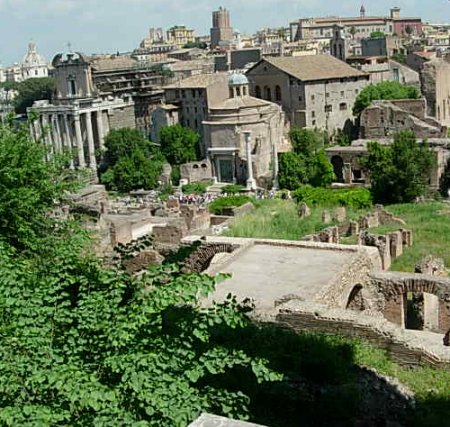
The Roman Forum today
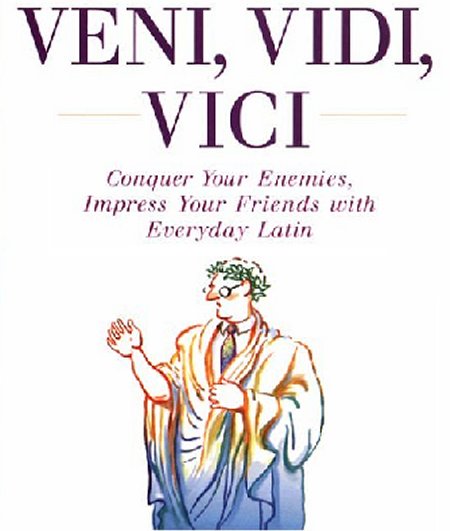
I
can safely say that my knowledge of Latin has never once
impressed my friends nor helped me conquer my enemies
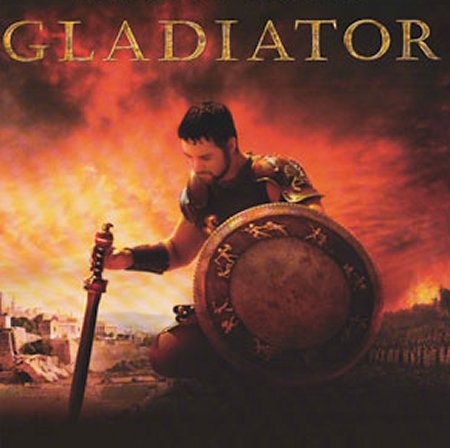
Russell
Crowe as the Gladiator, Oscar for Best Picture 2000
It was a brilliant film albeit a goofy ending
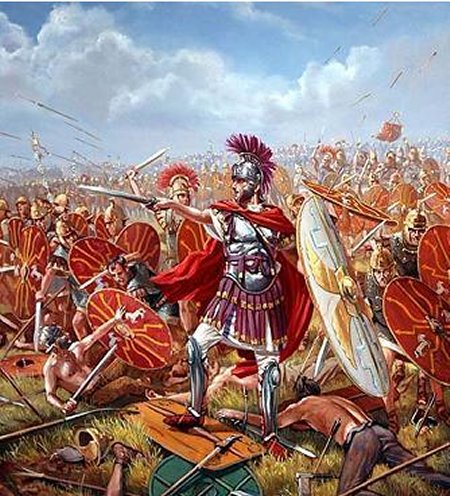
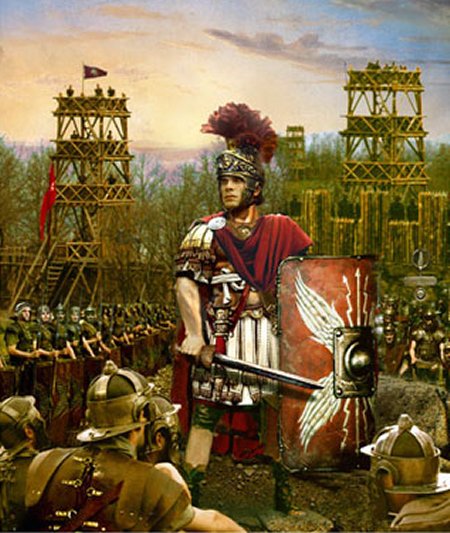
Julius
Caesar was one of the greatest military leaders in
history
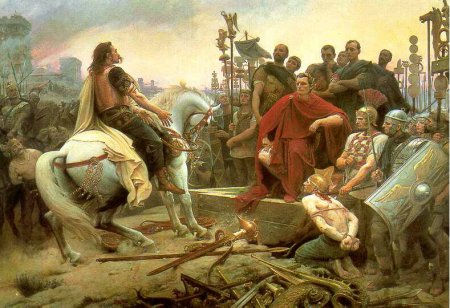
The Defeat of Vercingetorix
- Julius Caesar conquers Gaul
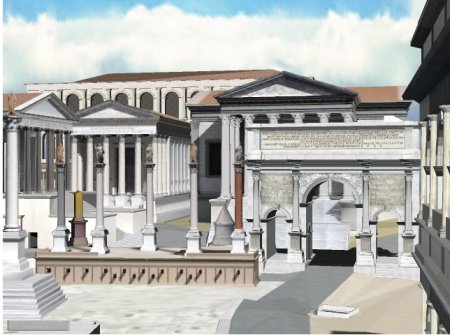
The Roman Forum of
yesterday
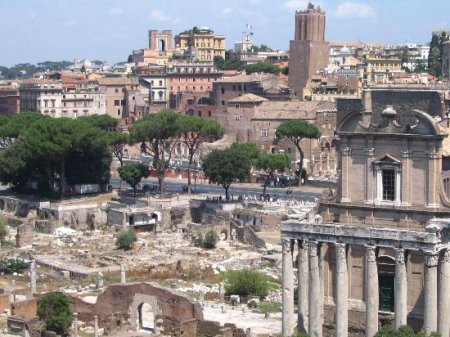
Today the Roman Forum is
largely in ruins
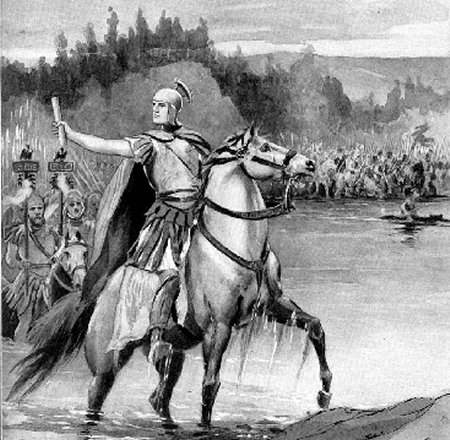
Defying the Senate: Caesar crosses the
Rubicon
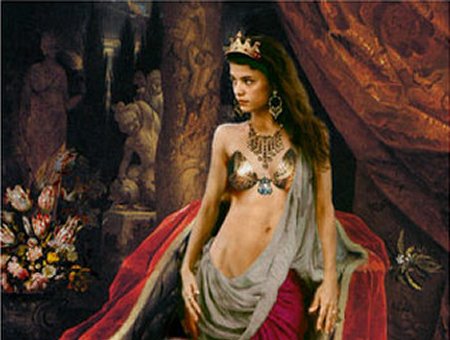
Cleopatra
used a rug to meet her new boyfriend
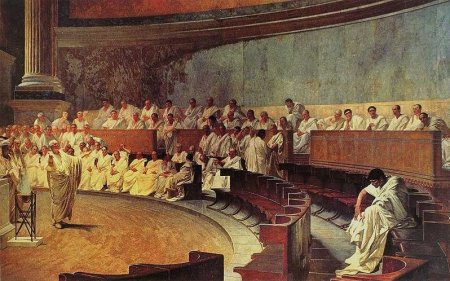
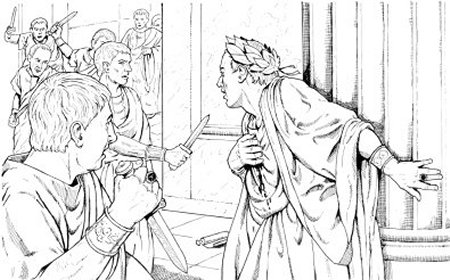
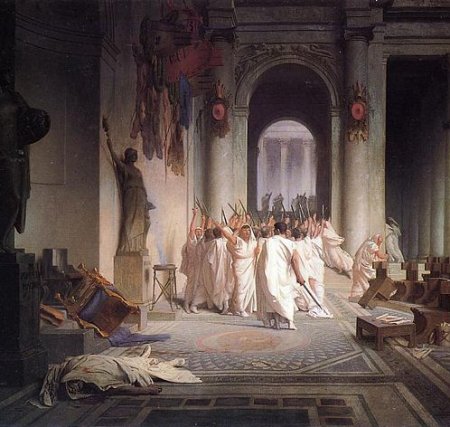
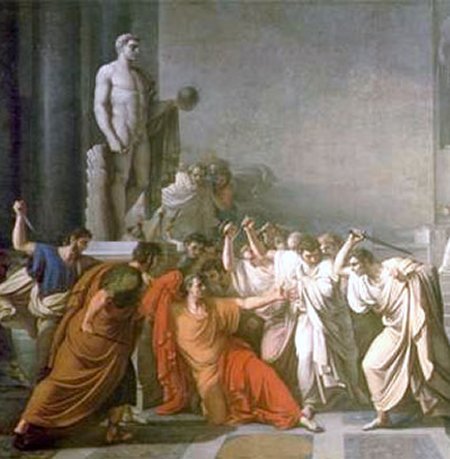
Et tu, Brute!
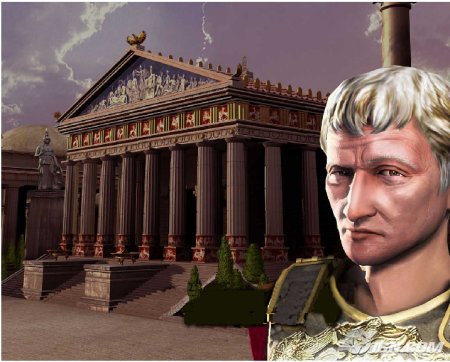
The Greatest Ruler in Roman History - Augustus Caesar
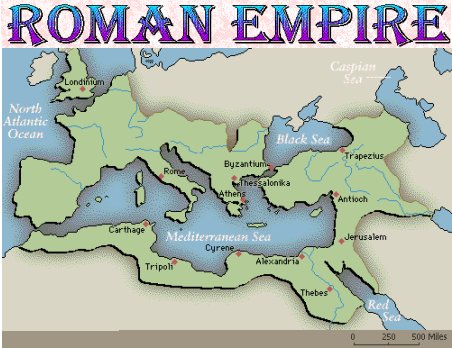 |
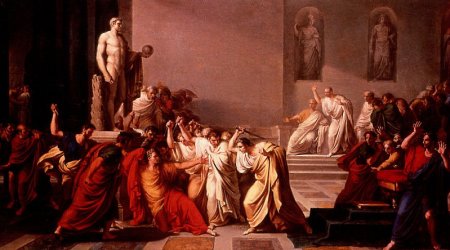
Beware the Ides of March:
Julius Caesar loses his life |
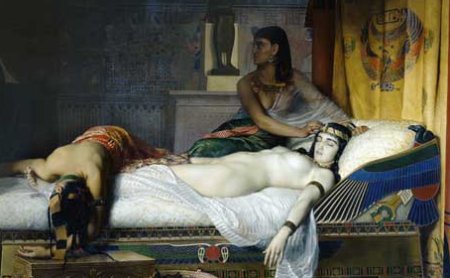
Cleopatra
takes her life. If it seems a lot of people lost
their lives during
the making of the Roman Empire, that's because they did. |
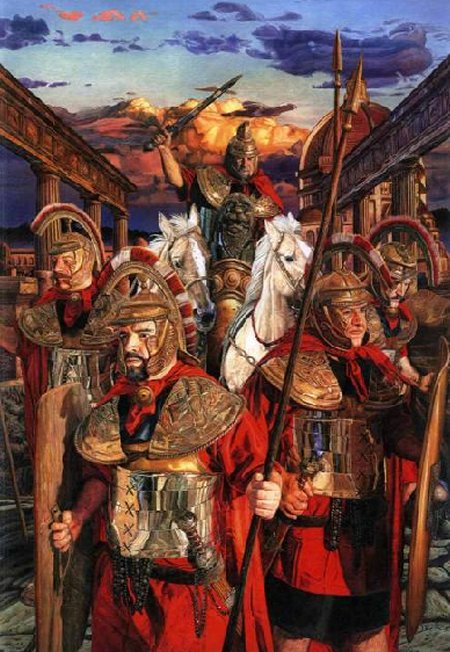
After
Caesar's assassination, Caesar's
armies transferred their loyalty to Octavian, a move
that Pompey never anticipated. Octavian was still a sickly teenager,
but he was a brilliant politician
|
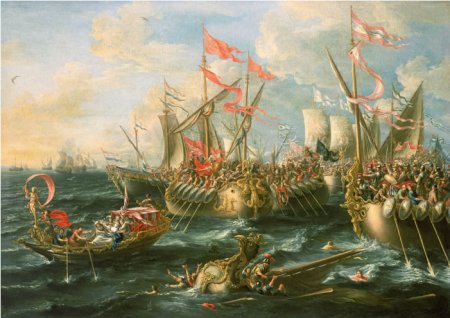
31
BC The Battle of Actium - Octavian defeats Antony
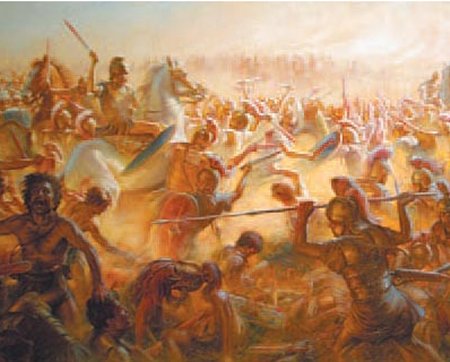 |
|
|